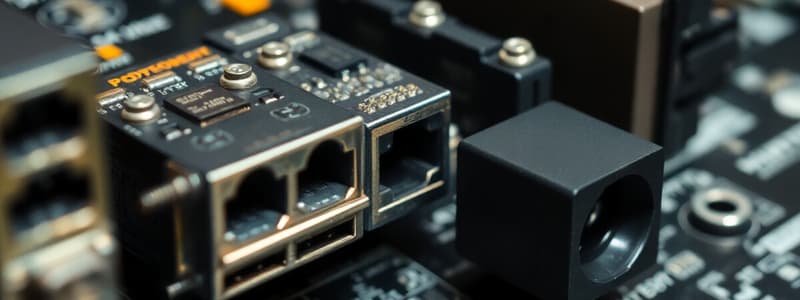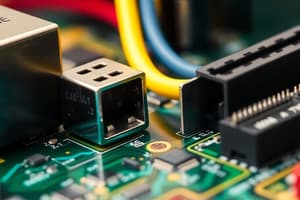Podcast
Questions and Answers
What is the primary function of the 24-pin connector on a motherboard?
What is the primary function of the 24-pin connector on a motherboard?
What does "ATX" stand for in the context of the 4-pin connector mentioned?
What does "ATX" stand for in the context of the 4-pin connector mentioned?
How many pins does the older version of the motherboard power connector have?
How many pins does the older version of the motherboard power connector have?
What is the purpose of the keys on the 24-pin connector?
What is the purpose of the keys on the 24-pin connector?
Signup and view all the answers
What voltage does the 4-pin ATX connector typically provide?
What voltage does the 4-pin ATX connector typically provide?
Signup and view all the answers
What feature on the 24-pin connector ensures it is securely locked in place?
What feature on the 24-pin connector ensures it is securely locked in place?
Signup and view all the answers
Why is it important to disconnect all power sources before connecting the power supply to the motherboard?
Why is it important to disconnect all power sources before connecting the power supply to the motherboard?
Signup and view all the answers
What is the main function of the 4-pin ATX connector on a motherboard?
What is the main function of the 4-pin ATX connector on a motherboard?
Signup and view all the answers
Which of the following connections would you use to install a new hard drive inside your computer?
Which of the following connections would you use to install a new hard drive inside your computer?
Signup and view all the answers
What is the purpose of the pin headers on a motherboard?
What is the purpose of the pin headers on a motherboard?
Signup and view all the answers
What is the purpose of the Trusted Platform Module (TPM) connector on a motherboard?
What is the purpose of the Trusted Platform Module (TPM) connector on a motherboard?
Signup and view all the answers
Which of the following is NOT a common function of a pin header on a motherboard?
Which of the following is NOT a common function of a pin header on a motherboard?
Signup and view all the answers
What is the primary difference between SATA and eSATA connections?
What is the primary difference between SATA and eSATA connections?
Signup and view all the answers
What is the primary use for the M.2 connector on a motherboard?
What is the primary use for the M.2 connector on a motherboard?
Signup and view all the answers
Which of the following is NOT a typical connector found on a motherboard?
Which of the following is NOT a typical connector found on a motherboard?
Signup and view all the answers
What is the purpose of the 'AAFP' pin headers on the motherboard?
What is the purpose of the 'AAFP' pin headers on the motherboard?
Signup and view all the answers
Which of the following is the correct way to secure an M.2 SSD to the motherboard?
Which of the following is the correct way to secure an M.2 SSD to the motherboard?
Signup and view all the answers
Why might someone use an eSATA connection?
Why might someone use an eSATA connection?
Signup and view all the answers
Flashcards
Motherboard Power Connector
Motherboard Power Connector
The main connector providing power to the motherboard, typically 24 pins.
Voltage Levels
Voltage Levels
Main motherboard power is provided at 3.3V, 5V, and 12V.
20-Pin Connector
20-Pin Connector
An older type of power connector that has 20 pins for the motherboard.
24-Pin Connector
24-Pin Connector
Signup and view all the flashcards
Keyed Pins
Keyed Pins
Signup and view all the flashcards
Connector Lock
Connector Lock
Signup and view all the flashcards
4-Pin ATX Connector
4-Pin ATX Connector
Signup and view all the flashcards
ATX Standard
ATX Standard
Signup and view all the flashcards
ATX 12 Volt
ATX 12 Volt
Signup and view all the flashcards
SATA
SATA
Signup and view all the flashcards
eSATA
eSATA
Signup and view all the flashcards
Pin Headers
Pin Headers
Signup and view all the flashcards
TPM
TPM
Signup and view all the flashcards
USB Connectors
USB Connectors
Signup and view all the flashcards
Cooling Fans
Cooling Fans
Signup and view all the flashcards
M.2 Connector
M.2 Connector
Signup and view all the flashcards
Case Connectors
Case Connectors
Signup and view all the flashcards
SSD Installation
SSD Installation
Signup and view all the flashcards
Study Notes
Motherboard Connectors
- Power Connectors:
- 24-pin ATX power: Standard power connector for motherboards, providing 3.3V ±5V and ±12V power.
- 20-pin connector compatibility: Older 20-pin connectors can be used with a 24-pin connector.
- Modular design: Some power supplies offer modular 24-pin connectors with additional pins.
- Keyed connectors: Pins are keyed to ensure proper insertion orientation.
- Locking mechanism: A locking mechanism prevents accidental disconnection.
- Orientation matters: Correct orientation is crucial before connecting.
CPU Power
- 4-pin ATX 12V connector: Provides 12V power to the CPU.
- Location: Usually near the CPU.
- Labeling: Often labeled as "CPU", "P4", or "ATX 12V".
- Keyed connector: Ensures proper insertion orientation.
Storage Connections
- SATA (Serial ATA) Connectors: Connectors for hard drives and solid-state drives (SSDs).
- Different layouts and colors: Some motherboards use different colors or layouts.
- eSATA (external Serial ATA): Allows connection of external storage devices.
- Expansion cards: eSATA connectors can be added via an expansion card.
Pin Headers
- Purpose: Provide connections for various components, such as power, USB, and case button control.
- Examples:
- AAFP: External audio connectors.
- TPM: Trusted Platform Module connector.
- USB connectors: Legacy and USB 3.0 connectors.
- Cooling fan controls: Power and control for cooling fans.
- Positioning: Located at the edge of the motherboard.
Case Connectors
- Connection method: Case buttons (power/reset), and lights (power/hard drive) connect to motherboard pin headers.
- Labeling for clarity: Connectors frequently labeled for correct use.
M.2 Connector
- Modern Motherboards: Newer motherboards support M.2 connector for SSD connectivity.
- Small form factor: Allows for smaller, high-performance storage.
- Installation process: Plug, push, and secure with screw.
Studying That Suits You
Use AI to generate personalized quizzes and flashcards to suit your learning preferences.
Description
Test your knowledge on various motherboard connectors with this quiz. From power connectors to CPU power and storage connections, explore how these components work together to support your computer's functionality. Ideal for electronics enthusiasts and students alike!



